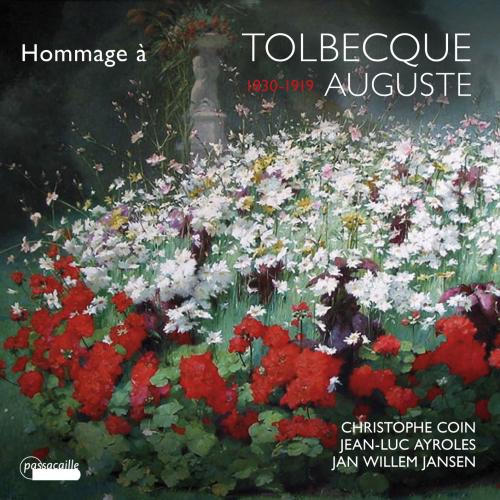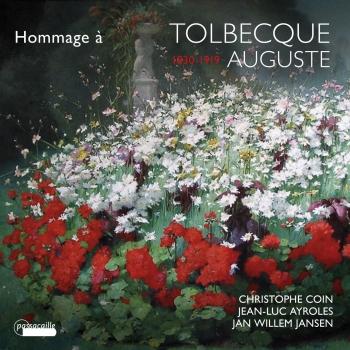
Hommage à Auguste Tolbecque Jean-Luc Ayroles, Christophe Coin & Jan Willem Jansen
Album Info
Album Veröffentlichung:
2019
HRA-Veröffentlichung:
19.02.2020
Label: Passacaille
Genre: Classical
Subgenre: Chamber Music
Interpret: Jean-Luc Ayroles, Christophe Coin & Jan Willem Jansen
Komponist: Auguste Tolbecque (1830-1919)
Das Album enthält Albumcover Booklet (PDF)
- Auguste Tolbecque (1830 - 1919): Barcarolle pour violoncelle et piano, Op. 6 No. 1:
- 1 Barcarolle pour violoncelle et piano, Op. 6 No. 1: Andante cantabile 03:13
- Danse cosaque ' Kozatchok' pour violoncelle seul, Op. 21:
- 2 Danse cosaque ' Kozatchok' pour violoncelle seul, Op. 21: Allegretto 02:22
- Auguste Tolbecque:
- 3 Rêverie pour violoncelle et orgue, Op. 9 05:17
- Musette pastorale pour violoncelle et piano, Op. 6 No. 2:
- 4 Musette pastorale pour violoncelle et piano, Op. 6 No. 2: Allegretto 02:03
- Auguste Tolbecque:
- 5 La Styrienne pour piano, Op. 4: Andante - Mouvement de valse 03:37
- Concertstuke [sic] pour violoncelle et piano, Op. 19:
- 6 Concertstuke [sic] pour violoncelle et piano, Op. 19: I. Romance cantabile 03:46
- 7 Concertstuke [sic] pour violoncelle et piano, Op. 19: II. Allegro agitato 05:19
- Deux pièces pour violoncelle solo sans accompagnement, Op. 22:
- 8 Deux pièces pour violoncelle solo sans accompagnement, Op. 22: Les Vagues - Moderato 02:47
- Auguste Tolbecque:
- 9 Prière pour violoncelle et orgue, Op. 9: Andantino religioso 04:36
- Après la Valse Ouverture pour piano à 4 mains, Op. 20:
- 10 Après la Valse Ouverture pour piano à 4 mains, Op. 20: Gaiement 04:10
- Sérénade et Saltarelle pour violoncelle et piano, Op. 7:
- 11 Sérénade et Saltarelle pour violoncelle et piano, Op. 7: I. Andantino 03:07
- 12 Sérénade et Saltarelle pour violoncelle et piano, Op. 7: II. Presto e spiritoso 02:49
- Elégie pour violoncelle et orgue, Op. 8:
- 13 Elégie pour violoncelle et orgue, Op. 8: Andante plaintivo 07:21
- Romance et Polonaise pour violoncelle et piano, Op. 5:
- 14 Romance et Polonaise pour violoncelle et piano, Op. 5: I. Romance 03:20
- 15 Romance et Polonaise pour violoncelle et piano, Op. 5: II. Polonaise 03:48
- Deux pièces pour violoncelle solo sans accompagnement, Op. 22:
- 16 Deux pièces pour violoncelle solo sans accompagnement, Op. 22: Marche des mousquetaires, 1727 (version pour viole par Christophe Coin) 02:58
- Fantaisie de Bravoure pour violoncelle et piano, Op. 13:
- 17 Fantaisie de Bravoure pour violoncelle et piano, Op. 13: Marziale - Thème et variation - Cantabile - Allegretto 11:38
- Andante et Rondo pour violoncelle et piano, Op. 10:
- 18 Andante et Rondo pour violoncelle et piano, Op. 10: I. Andante 02:35
- 19 Andante et Rondo pour violoncelle et piano, Op. 10: II. Rondo 02:58
Info zu Hommage à Auguste Tolbecque
Entdeckenswerte Cellikatessen: Der Franzose Auguste Tolbecque ist selbst den meisten Fachleuten bislang nur als herausragender Cellist und bedeutender Pionier des historischen Instrumentenbaus ein Begriff. Eingang in die musikhistorischen Annalen fand er als gefeierter Virtuose, der beispielsweise 1873 die Uraufführung von Camille Saint-Saëns’ erstem Cellokonzert besorgte. Darüber hinaus sammelte Tolbecque mit großer Leidenschaft historische Streichinstrumente, die er nach eingehendem Studium als einer der ersten detailgetreu kopierte und erfolgreich ausstellte. Doch war der gebürtige Belgier auch ein gefragter Dirigent und Musikpädagoge, aber vor allem erwies er sich auch als ein höchst bemerkenswerter Komponist. Ein Aspekt, der bislang allerdings mangels moderner Editionen seiner Werke kaum beleuchtet wurde. Der renommierte Cellist und Gambist Christophe Coin hat zusammen mit den Pianisten Jean-Luc Ayroles und dem Organisten Jan Willem Jansen für das Label PASSACAILLE einige der entdeckenswerten Kompositionen Tolbecques für sein Instrument sowie einige Klavierwerke eingespielt, die diesen nicht nur als außergewöhnlichen Virtuosen in der Tradition Paganinis, sondern auch als äußerst charmanten Unterhalter und geschickten Lehrer zeigen. Dank des mitreißenden Engagements aller Beteiligten entstand hier eine überfällige Würdigung zum 100. Todestag des Komponisten und beschert so den Freunden melodieseliger Cellomusik der französischen Spätromantik manche reizvolle »Cellikatesse«, die man sich immer wieder gerne kredenzen lässt.
Christophe Coin, Cello
Jean-Luc Ayroles, Klavier
Jan Willem Jansen, Orgel
Caroline Esposito, Klavier
Jean-Luc Ayroles
Born in Toulouse, Jean-Luc Ayroles took his first piano lessons and percussion at the age of six. Very soon encouraged by Françoise Thinat, he entered the Conservatoire National Supérieur de Musique de Paris where he studied piano under Yvonne Loriod, chambre music under Michel Cals and deciphering under Marie-Françoise Bucquet. He was awarded first prizes in piano, vocal accompaniment and chamber music. In 1993, he perfected his skills with Colette Zerah, professor at the Academy of Music in Darmstadt. During his musical training, he took part in master-classes with Irène Aïtoff, Dominique Merlet, Martin Isepp, Roger Muraro, Michel Beroff and Jean Mouillère.
His career led him to perform along famous orchestras like: Orchestre Philharmonique de Radio France, Orchestre du Capitole de Toulouse and the Orchestre Philharmonique de Monaco, with noted conductors such as Gustavo Dudamel, Paavo Järvi, Myung Whun Chung, Peter Eötvös, Eliahu Inbal.
His work as a soloist was noted for his performance of Messiaen’s complete “Vingt regards sur l’enfant Jésus” and “Trois petites lithurgies”, while a soloist with the Ensemble Orchestral de Paris in 2008, as well as his interpretation of the four last sonatas by Beethoven (Télérama event). In 2004, he crisscrossed the West Bank (Palestine) with the association Al Kamandjâti conducting educational workshops and concerts of classical and arab music in refugees camp.
Jean-Luc Ayroles appeared in many festivals including "Presence" of radio-France, Gigondas, La Borie in Limousin, Palais des Arts de Nogent, Moulin d’Andé, and also abroad in Japan, Israel, USA, Cyprus and in Europe. He continued chamber music work with along Christophe Coin, Catherine Cournot, Sophie Koch, and Hélène Collerette. Member of the TM + Ensemble since 2007, he recorded in Copenhagen Chamber of Niels Rosing-show works.
Professor at the Conservatory of Centre de Paris, he gave master-class in Japan, Israel, and in France.
His new CD " Vingt Regards sur l’Enfant Jésus" from Olivier Messiaen will come out in November 2016 with Calliope label. A highly-anticipated album from this rarely register masterpiece which is already welcomed as " France Musique choice ".
Christophe Coin
Perhaps the leading post-Harnoncourt cellist in the early music movement, Christophe Coin has developed a particular interest in music of late eighteenth century Vienna. He began studying the cello as a child in Caen, then enrolled in the Paris Conservatory, where his principal teacher was André Navarra. After taking first prize in a conservatory competition, Coin moved to Vienna where, at the Academy for Music, he became a disciple of Nikolaus Harnoncourt and performed in the latter’s Concentus Musicus.Coin also studied with gamba guru Jordi Savall at the Schola Cantorum in Basle. Through Savall, he was able to perform with the ensemble Hesperion XX.
Coin joined England’s Academy of Ancient Music, with which he made several recordings as an orchestra member and as a soloist. In 1984 he founded his own chamber orchestra, Ensemble Mosaïques, but dissolved it the following year. He did salvage the name, at least, when he recruited leaders of its string section to join him in forming the Quatuor Mosaïques, a group mainly dedicated to the music of Mozartand Haydn, but also moving forward into scores by Beethoven and Schubert. In 1991 he was also named music director of the Limoges Baroque Ensemble.
His academic appointments include a post at the Schola Cantorum in Basle, and heading studies in Baroque cello and viola da gamba at the Conservatoire National Supérieur in Paris. Although his performing career has been centered in Europe, Coin has become known to North American audiences through his recordings. Among his more CD projects are highly regarded recordings of Classical-era quartets, and a series of discs devoted to Bach cantatas featuring the violoncello piccolo.
Jan Willem Jansen
was born in Holland.
In 1977 he graduated as soloist at the Royal Conservatory of the Haye, then he improved the harpsichord playing, in Amsterdam. He went to France to work with Xavier Darasse and became his pedagogical collaborator at the Toulouse Conservatory. Here he contributed to the ancient music department’s foundation and collaborated with Michel Bouvard for the new Organ superior department.
He played with the best baroque ensembles and became the titular of the Augustins’ Museum and Notre-Dame de la Daurade Basilique’s organs.
He recorded many CDs and, in 1996, he founded with Michel Bouvard the “Festival International Toulouse les Orgues”.
Booklet für Hommage à Auguste Tolbecque













